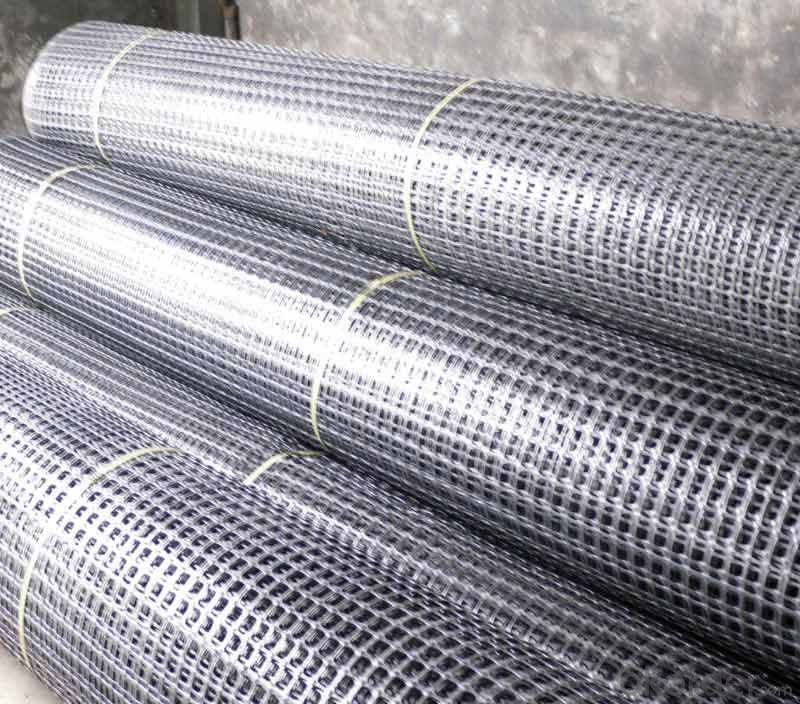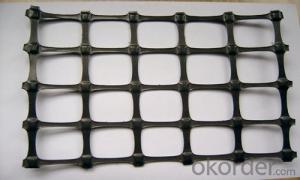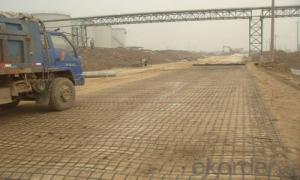High Density Biaxial Geogrids in Highway for Civil Engineering Construction
- Loading Port:
- China main port
- Payment Terms:
- TT OR LC
- Min Order Qty:
- 1000 m²
- Supply Capability:
- 10000000 m²/month
OKorder Service Pledge
OKorder Financial Service
You Might Also Like

Introduction
Type:
Geogrids
Place of Origin:
Shandong, China (Mainland)
Brand Name:
OEM or Road
Model Number:
EGA50-50, EGA80-80, EGA100-100
We have three types of Geogrids; extruded, woven and bonded. Extruded Geogrids are flat structures in polymer (usually high density polyethylene or polypropylene) that are extruded and then pulled: this may be done in one direction (mono-oriented geogrids), or in the two main directions (bi-oriented geogrids). They are used in soil and road paving reinforcement.
Bonded Geogrids are flat structures, where two or more series of strip elements made of polyester coated with polyethylene, are linked at regular intervals by means of bonding.
Woven Geogrids are flat structures in the shape of a net made of high module synthetic fibres, that may also be coated with a further protection layer, using synthetic material (usually PVC or other polymer).
Geogrid application filled with ground material is one of the easy of soil reinforcement. The thickness of such construction may be 50% less than the thickness of standard replacement which allows avoiding costly soil replacement.
Our Service
Quality assurance
1.On a regular basis or as per your request,we entrust national testing agencies to conduct quality inspections
2. Strictly in accordance with the ISO9001-2008 international quality system standard,we monitor and manage the whole process throughout production,quality testing,and measurement to ensure product quality
3. For quality-related construction delay or substandard construction(except for damage or losses due to customer’s responsibility or irresistible natural disasters),we have refunding,replacement,and repair services.We will respond to customers’ feedbacks on quality issues within 24 hours.
Packaging & Shipping
Packing: PLASTIC FILM INSIDE, AND WOVEN BAG OUTSIDE
Shipping: About 15 days after receipt the deposit
FAQ:
Q: What kind of payments does jenor support?
A: T/T, L/C, Cash are accepted.
Q: Do you charge for the samples?
A: Accordeing to our company policy, the samples are free, we only charge the freight fee. And we will return the freight fee during the next order.
Q: Can you produce according to customers' design?
A: Sure, we are professional manufacturer, OEM and ODM are both welcome.
Q: Do you have other products?
A: Yes, please check the pictures:
- Q:The difference between composite geomembrane and bentonite waterproof blanket
- Different waterproof performance. Composite geomembrane: composite geomembrane composite impermeable membrane is divided into one cloth and two membrane. Tensile, tearing resistance, bursting and other physical and mechanical properties of high index, the product has high strength, good elongation, deformation modulus, acid and alkali resistance, corrosion resistance, aging resistance, good performance of seepage control, etc..
- Q:Do geogrids enhance the load-bearing capacity of soil?
- Yes, geogrids enhance the load-bearing capacity of soil.
- Q:How do geogrids improve the performance of geosynthetic-reinforced slopes in liquefaction-prone areas?
- Geogrids improve the performance of geosynthetic-reinforced slopes in liquefaction-prone areas by enhancing the stability and strength of the soil. They act as a reinforcement material, providing additional tensile strength to the soil structure, thereby reducing the potential for slope failure during liquefaction events. Geogrids also help to distribute the applied loads more uniformly, mitigating the concentrated stress and reducing the chances of liquefaction occurrence. Overall, geogrids improve the resilience and resistance of geosynthetic-reinforced slopes in liquefaction-prone areas, making them more reliable and less susceptible to failure.
- Q:Can geogrids be used in retaining wall reinforcement systems?
- Yes, geogrids can be used in retaining wall reinforcement systems. Geogrids are commonly used to improve the stability and performance of retaining walls by providing reinforcement and enhancing soil retention. They help to distribute lateral forces and reduce soil movement, thereby increasing the overall strength and durability of the retaining wall.
- Q:What is a geogrid?
- A geogrid is a type of geosynthetic material made of polymer or fiberglass that is used to reinforce soil or other materials in civil engineering projects. It is commonly used to increase the strength and stability of retaining walls, slopes, and roadways by distributing the load and preventing soil movement.
- Q:How do geogrids improve the performance of geosynthetic tube structures?
- Geogrids improve the performance of geosynthetic tube structures by providing enhanced strength and stability. They act as a reinforcement element, distributing and transferring loads more efficiently across the structure. This reinforcement helps to mitigate potential deformations and structural failures, ultimately increasing the overall performance and longevity of the geosynthetic tube structures.
- Q:Fiberglass geogrid is mainly used for old road reconstruction, the main purpose is to reduce reflection
- Geotextiles are used for road, railway, tunnel, dam, tailings treatment, isolation, filtration, drainage, reinforcement, protection and enhancement...Analysis of the causes of cracks in the asphalt overlay, the formation of a new type of excellent geotechnical substrates by special coating process.Asphalt overlay on old cement concrete pavement is a kind of special pavement structure, and its stress and strain characteristics are quite different from those of general elastic layered system.
- Q:What is the effect of creep on geogrid performance?
- Creep can have a significant impact on the performance of geogrids. Over time, the constant stress and strain on the geogrid can cause it to slowly deform and lose its original shape and strength. This can result in reduced load-bearing capacity and overall effectiveness of the geogrid in reinforcing and stabilizing the soil. It is important to consider creep behavior when designing and selecting geogrids for long-term applications to ensure their durability and performance.
- Q:Can geogrids be used in gabion wall construction?
- Yes, geogrids can be used in gabion wall construction. Geogrids are often used to reinforce the structure of gabion walls, providing additional strength and stability. They are typically placed within the gabion baskets to improve the overall performance and durability of the wall.
- Q:How do geogrids help in reducing the risk of soil erosion?
- Geogrids help in reducing the risk of soil erosion by providing reinforcement to the soil, increasing its stability and resistance to erosion. They are typically made of strong materials, such as plastic or polymer, and are installed beneath the topsoil or within the soil layers. Geogrids act as a barrier, distributing the load and reducing the pressure on the soil. This prevents soil particles from being washed away by water or wind, thus minimizing erosion and preserving the integrity of the landscape.
1. Manufacturer Overview |
|
|---|---|
| Location | |
| Year Established | |
| Annual Output Value | |
| Main Markets | |
| Company Certifications | |
2. Manufacturer Certificates |
|
|---|---|
| a) Certification Name | |
| Range | |
| Reference | |
| Validity Period | |
3. Manufacturer Capability |
|
|---|---|
| a)Trade Capacity | |
| Nearest Port | |
| Export Percentage | |
| No.of Employees in Trade Department | |
| Language Spoken: | |
| b)Factory Information | |
| Factory Size: | |
| No. of Production Lines | |
| Contract Manufacturing | |
| Product Price Range | |
Send your message to us
High Density Biaxial Geogrids in Highway for Civil Engineering Construction
- Loading Port:
- China main port
- Payment Terms:
- TT OR LC
- Min Order Qty:
- 1000 m²
- Supply Capability:
- 10000000 m²/month
OKorder Service Pledge
OKorder Financial Service
Similar products
New products
Hot products
Related keywords































